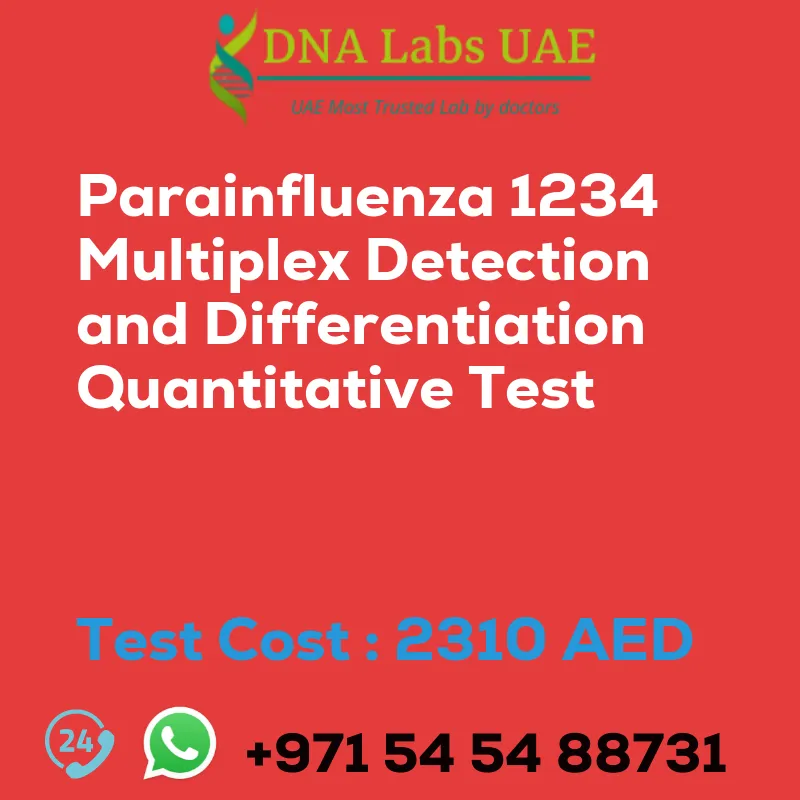Parainfluenza 1234 Multiplex Detection and Differentiation Quantitative Test
Test Name: Parainfluenza 1234 Multiplex Detection and Differentiation Quantitative Test
Components: Bronchial Swab, Bronchial Lavage, Sputum, Nasopharyngeal (NP) aspirates and swabs in viral transport medium, or lung tissues, etc.
Price: 2310.0 AED
Sample Condition: Bronchial Swab, Bronchial Lavage, Sputum, Nasopharyngeal (NP) aspirates and swabs in viral transport medium, or lung tissues, etc.
Report Delivery: 4th Working Day (Email: 48 hours, On phone: 36 hours)
Method: Real Time RT-PCR
Test Type: Viral
Doctor: Physician
Test Department: Genetics
Pre Test Information: Need to sign Consent document and bring any clinical history of patient for Parainfluenza 1,2,3,4 Multiplex Detection & Differentiation Quantitative Test
Test Details
The Parainfluenza 1234 Multiplex Detection and Differentiation Quantitative Test is a diagnostic test used to detect and differentiate between the four types of parainfluenza viruses (1, 2, 3, and 4) in a patient sample. This test is quantitative, meaning it provides information about the amount of each virus present in the sample.
Parainfluenza viruses are a common cause of respiratory infections, especially in children. They can cause symptoms similar to the common cold, such as cough, runny nose, and fever, but in some cases, they can lead to more severe respiratory illnesses like croup or pneumonia.
The multiplex detection and differentiation test uses molecular techniques, such as polymerase chain reaction (PCR), to amplify and detect specific genetic material from each parainfluenza virus. By targeting unique regions of the viral genome, the test can accurately identify and distinguish between the different types of parainfluenza viruses.
The quantitative aspect of the test provides information about the viral load, or the amount of each virus present in the sample. This information can be useful in assessing the severity of the infection and monitoring the effectiveness of treatment.
Overall, the Parainfluenza 1234 Multiplex Detection and Differentiation Quantitative Test is a valuable tool in the diagnosis and management of parainfluenza virus infections. It allows for rapid and accurate identification of the specific virus type and provides quantitative data to guide treatment decisions.
| Test Name | Parainfluenza 1234 Multiplex Detection and Differentiation Quantitative Test |
|---|---|
| Components | |
| Price | 2310.0 AED |
| Sample Condition | Bronchial Swab, Bronchial Lavage, Sputum, Nasopharyngeal (NP) aspirates and swabs in viral transport medium, or lung_x000D_\ntissues., etc. |
| Report Delivery | 4th Working Day Email : 48 hours.On phone : 36 hours |
| Method | Real Time RT- PCR |
| Test type | Viral |
| Doctor | Physician |
| Test Department: | Genetics |
| Pre Test Information | Need to sign Consent document and bring any clinical history of patient forParainfluenza 1,2,3,4 Multiplex Detection & Differentiation QuantitativeTest |
| Test Details |
Parainfluenza 1,2,3,4 Multiplex Detection & Differentiation Quantitative Test is a diagnostic test used to detect and differentiate between the four types of parainfluenza viruses (1, 2, 3, and 4) in a patient sample. This test is quantitative, meaning it provides information about the amount of each virus present in the sample. Parainfluenza viruses are a common cause of respiratory infections, especially in children. They can cause symptoms similar to the common cold, such as cough, runny nose, and fever, but in some cases, they can lead to more severe respiratory illnesses like croup or pneumonia. The multiplex detection and differentiation test uses molecular techniques, such as polymerase chain reaction (PCR), to amplify and detect specific genetic material from each parainfluenza virus. By targeting unique regions of the viral genome, the test can accurately identify and distinguish between the different types of parainfluenza viruses. The quantitative aspect of the test provides information about the viral load, or the amount of each virus present in the sample. This information can be useful in assessing the severity of the infection and monitoring the effectiveness of treatment. Overall, the Parainfluenza 1,2,3,4 Multiplex Detection & Differentiation Quantitative Test is a valuable tool in the diagnosis and management of parainfluenza virus infections. It allows for rapid and accurate identification of the specific virus type and provides quantitative data to guide treatment decisions. |








